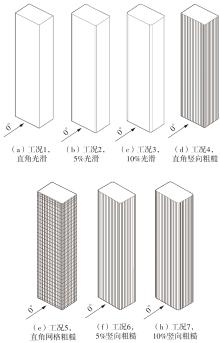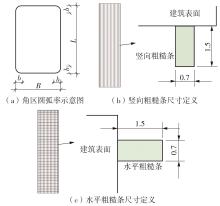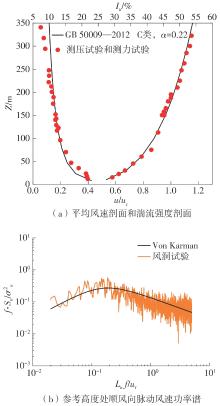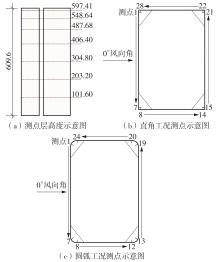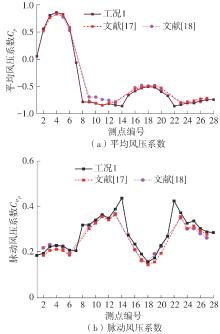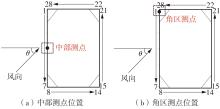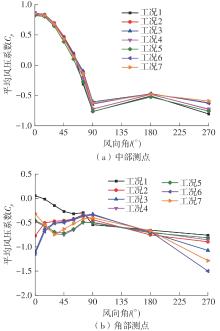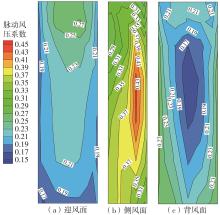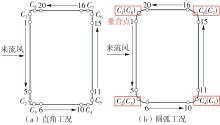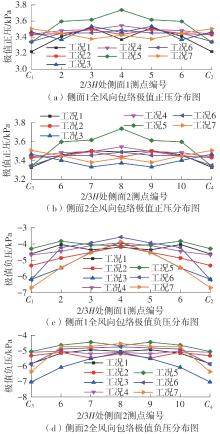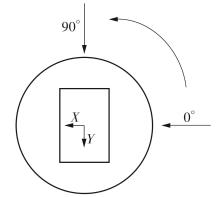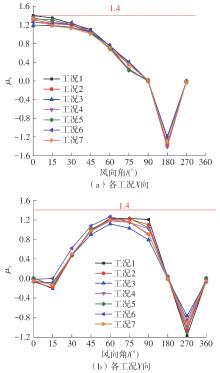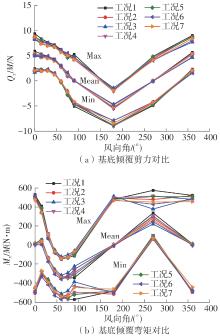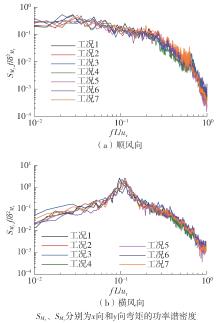Journal of South China University of Technology(Natural Science Edition) ›› 2025, Vol. 53 ›› Issue (8): 100-110.doi: 10.12141/j.issn.1000-565X.240485
• Architecture & Civil Engineering • Previous Articles Next Articles
Study on the Influence of Rounded Corner and Rough Strips on Wind Load of CAARC Model
YANG Yi1, WU Jian1, WANG Xin2, XU Zhouyang3
- 1.State Key Laboratory of Subtropical Building and Urban Science,South China University of Technology,Guangzhou 510640,Guangdong,China
2.Liwan District Construction Engineering Quality Supervision Station,Guangzhou 510175,Guangdong,China
3.Yichang Municipal Housing and Urban Renewal Bureau,Yichang 443000,Hubei,China
-
Received:2024-09-28Online:2025-08-25Published:2025-01-24 -
About author:杨易(1975—),男,博士,教授,主要从事风工程研究。E-mail: ctyangyi@scut.edu.cn -
Supported by:the National Natural Science Foundation of China(52178480)
CLC Number:
Cite this article
YANG Yi, WU Jian, WANG Xin, XU Zhouyang. Study on the Influence of Rounded Corner and Rough Strips on Wind Load of CAARC Model[J]. Journal of South China University of Technology(Natural Science Edition), 2025, 53(8): 100-110.
share this article
| [1] | 建筑结构荷载规范: [S]. |
| [2] | 邹云峰,陈政清,牛华伟 .模型表面粗糙度对冷却塔风致响应及干扰的影响[J].空气动力学学报,2014,32(3):388-394. |
| ZOU Yunfeng, CHEN Zhengqing, NIU Huawei .Influence of model surface roughness on wind-induced response and interference of cooling tower[J].Acta Aerodynamica Sinica,2014,32(3):388-394. | |
| [3] | 黄东梅,何世青,朱学,等 .表面粗糙度对超高层建筑风荷载与风振响应的影响[J].湖南大学学报(自然科学版),2017,44(9):41-51. |
| HUANG Dongmei, HE Shiqing, ZHU Xue,et al .Influence of surface roughness on wind load and wind-induced response of super-tall building[J].Journal of Hunan University (Natural Sciences),2017,44(9):41-51. | |
| [4] | STATHOPOULOS T, ZHU X .Wind pressures on buildings with mullions[J].Journal of Structural Engineering,1990,116(8):2272-2291. |
| [5] | QUAN Y, HOU F, GU M .Effects of vertical ribs protruding from facades on the wind loads of super highrise buildings[J].Wind and Structures,2017,24(2):145-169. |
| [6] | YUAN K, HUI Y, CHEN Z .Effects of façade appurtenances on the local pressure of high-rise building[J].Journal of Wind Engineering and Industrial Aerodynamics,2018,178:26-37. |
| [7] | 全涌,邱宏浩,张正维,等 .高层建筑水平悬挑遮阳板风荷载的风洞试验研究[J].建筑结构学报,2022,43(3):92-97. |
| QUAN Yong, QIU Honghao, ZHANG Zhengwei,et al .Wind tunnel test study on wind load of overhanging horizontal sunshade of hing-rise buildings[J].Journal of Building Structures,2022,43(3):42-97. | |
| [8] | YANG Q, LIU Z, HUI Y,et al .Modification of aerodynamic force characteristics on high-rise buildings with arrangement of vertical plates[J].Journal of Wind Engineering and Industrial Aerodynamics,2020,200:104155/1-18. |
| [9] | CHEN F B, LIU H M, CHEN W,et al .Characterizing wind pressure on CAARC standard tall building with various façade appurtenances:an experimental study[J].Journal of Building Engineering,2022,59:105015/1-10. |
| [10] | 庄翔,郑毅敏,郑晓芬,等 .不同圆角率下矩形高层建筑风荷载特性[J].建筑结构学报,2018,39(S1):1-8. |
| ZHUANG Xiang, ZHENG Yimin, ZHENG Xiaofen,et al .Wind load characteristics of rectangular high-rise buildings with various rounder corner ratios[J].Journal of Building Structures,2018,39(S1):1-8. | |
| [11] | KAWAI H .Effect of corner modifications on aeroelastic instabilities of tall buildings[J].Journal of Wind Engineering and Industrial Aerodynamics,1998,74:719-729. |
| [12] | TAMURA T, MIYAGI T, KITAGISHI T .Numerical prediction of unsteady pressures on a square cylinder with various corner shapes[J].Journal of Wind Engineering and Industrial Aerodynamics,1998,74:531-542. |
| [13] | LI S, DENG Y, ZHONG Z,et al .Effects of corner modifications on wind-induced responses of super high-rise buildings by wind tunnel tests based on a novel low-damping elastic test model[J].Journal of Building Engineering,2023,67:105881/1-15. |
| [14] | 建筑工程风洞试验方法标准: [S]. |
| [15] | 王新荣,顾明,全涌 .圆角处理的断面宽厚比为2∶1的二维矩形柱体气动力系数的雷诺数效应研究[J].工程力学,2016,33(1):64-71. |
| WANG Xinrong, GU Ming, QUAN Yong .Experimental study of reynolds number effects on aerodynamic forces for 2∶1 rectangular prisms with various rounded corners[J].Engineering Mechanics,2016,33(1):64-71. | |
| [16] | 杨群,于畅,刘小兵,等 .不同圆角率的方形断面斯特罗哈数的雷诺数效应研究[J].振动与冲击,2023,42(11):223-231. |
| YANG Qun, YU Chang, LIU Xiaobing,et al .Reynolds number effect of strouhal number of square prism with different rounded corner ratios[J].Journal of Vibration and Shock,2023,42(11):223-231. | |
| [17] | 王怡静 .基于CAARC标准模型风洞试验的风场参数影响研究[D].哈尔滨:哈尔滨工业大学,2020. |
| [18] | 徐安 .超高层建筑结构风效应的现场实测与风洞试验研究[D].广州:华南理工大学,2016. |
| [19] | MARUTA E, KANDA M, SATO J .Effects on surface roughness for wind pressure on glass and cladding of buildings[J].Journal of Wind Engineering and Industrial Aerodynamics,1998,74:651-663. |
| [20] | OKUDA Y, TANIIKE Y .Conical vortices over side face of a three-dimensional square prism[J].Journal of Wind Engineering and Industrial Aerodynamics,1993,50:163-172. |
| [21] | 沈国辉,钱涛,罗蒋皓,等 .不同长宽比矩形截面高层建筑的风荷载研究[J].湖南大学学报(自然科学版),2015,42(3):77-83. |
| SHEN Guohui, QIAN Tao, LUO Jianghao,et al .Study of wind loading on rectangular high-rise buildings with various length-to-width ratios[J].Journal of Hunan University (Natural Sciences),2015,42(3):77-83. |
| [1] | YANG Yi, WANG Zhe, ZHANG Zhiyuan. LES Study on the Influence of Streamlined Accessories on the Wind Loads of TTU Model [J]. Journal of South China University of Technology(Natural Science Edition), 2025, 53(2): 136-148. |
| [2] | ZHANG Binyu, WANG Yigang, YU Wuzhou, et al. Experimental Study on the Noise and Transmission of Automobile Door Sealing Cavity [J]. Journal of South China University of Technology(Natural Science Edition), 2024, 52(9): 104-114. |
| [3] | YANG Yi, WANG Xin, JI Changhui. Wind Tunnel Test Research on the Effect of Rough Strips on Wind Loads of A Super High-Rise Building [J]. Journal of South China University of Technology(Natural Science Edition), 2023, 51(4): 1-8. |
| [4] | ZHANG Xiang YAN Quansheng JIA Buyu LIU Muguang YU Xiaolin. The Study of Wind Tunnel Test and Numerical Simulation of Aerodynamic Interference on Adjacent Three Separated Deck Bridges [J]. Journal of South China University of Technology(Natural Science Edition), 2021, 49(12): 101-112. |
| [5] | YOU Yi YAN Zhitao LI Xinmin ZHONG Yongli HUANG Hanjie. Wind tunnel tests on drag coefficients of multiple-insulator strings [J]. Journal of South China University of Technology (Natural Science Edition), 2018, 46(9): 66-72. |
| [6] | HUANG Zundi LIANG Xifeng CHANG Ning YIN Zhichun HUANG Yuming ZHENG Jiongjie MO Guangxing. Optimization Research on Cross-section of Intercity EMU Body Based on LES [J]. Journal of South China University of Technology (Natural Science Edition), 2018, 46(9): 109-115. |
| [7] | Li Xiao-kang Xie Zhuang-ning Wang Zhan. Rapid Algorithm and Its Application of Wind-Induced Vibration Response of Super High-Rise Building Under the Control of Multiple Tuned Mass Dampers [J]. Journal of South China University of Technology(Natural Science Edition), 2012, 40(4): 118-124. |
| [8] | Zhu Bing-hu Zhang Qi-lin. Monitoring and Analysis of Wind Effect on Membrane Roof of Expo Axis [J]. Journal of South China University of Technology(Natural Science Edition), 2012, 40(2): 13-18. |
| [9] | Xie Zhuang-ning Liu Shuai Shi Bi-qing. Investigation into Wind Tunnel Test of Standard Low-Rise Building Model [J]. Journal of South China University of Technology (Natural Science Edition), 2011, 39(6): 106-112. |
| [10] | Xie Zhuang-ning Zhu Jian-bo. Distribution Characteristics of Mean Wind Pressure on Tall Buildings [J]. Journal of South China University of Technology (Natural Science Edition), 2011, 39(4): 128-134. |
| [11] | Xiao Zheng-zhi Li Zheng-liang Wang Zhi-song Yan Zhi-tao. Spatial Distribution Estimation of Wind Loads on Transmission Tower Based on High-Frequency Force Balance Tests [J]. Journal of South China University of Technology (Natural Science Edition), 2009, 37(6): 147-152. |
| [12] | Hou Jia-jian Han Xiao-lei Xie Zhuang-ning . Wind Load Characteristics of Twin-Tower Corridor-Connected Tall Building with Complex Shape [J]. Journal of South China University of Technology (Natural Science Edition), 2008, 36(3): 121-127. |
| [13] | Liu Yue-xing, Wang Fan, Wu Bo, et al. Wind Tunnel Test of Inclined Long-span Flat Roof in Complex Circumstance [J]. Journal of South China University of Technology(Natural Science Edition), 2004, 32(11): 75-80. |
| [14] | Fu J-i yang Gan Quan . Neural Network Models for Describing Characteristics of Wind Pressure Distribution on Large Span Flat Roof [J]. Journal of South China University of Technology(Natural Science Edition), 2003, 31(8): 62-66. |
| Viewed | ||||||
|
Full text |
|
|||||
|
Abstract |
|
|||||
